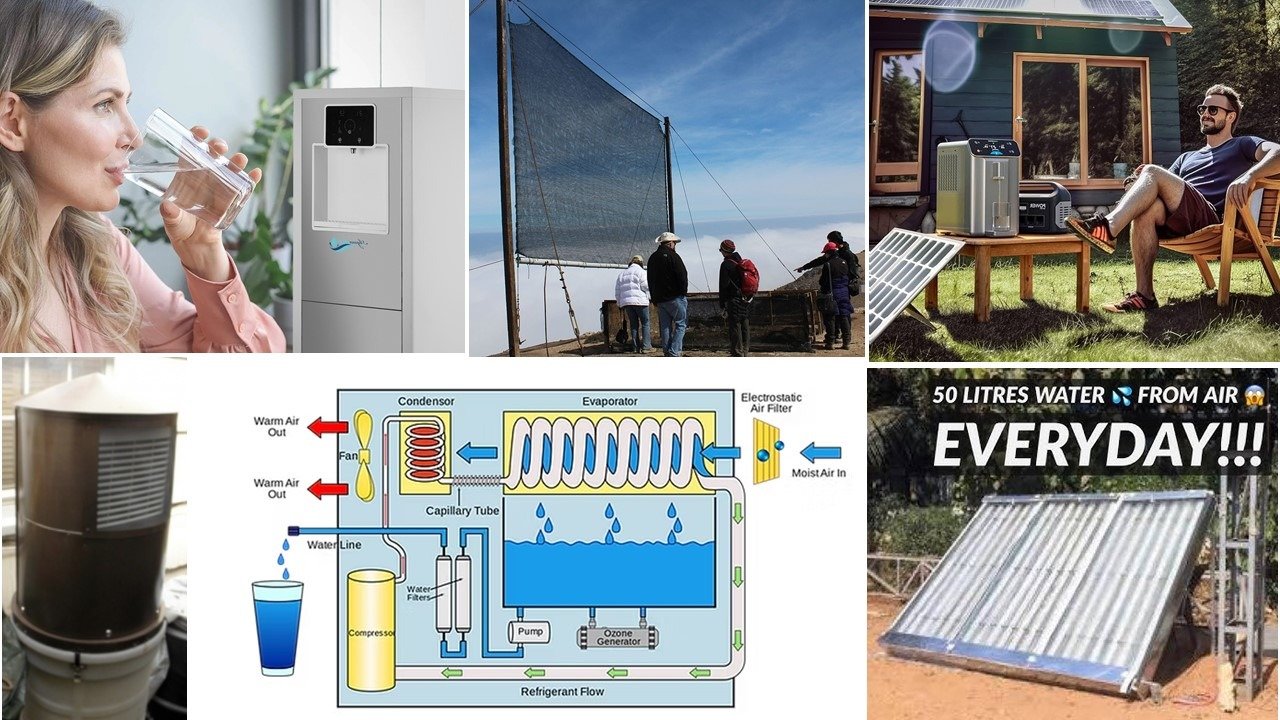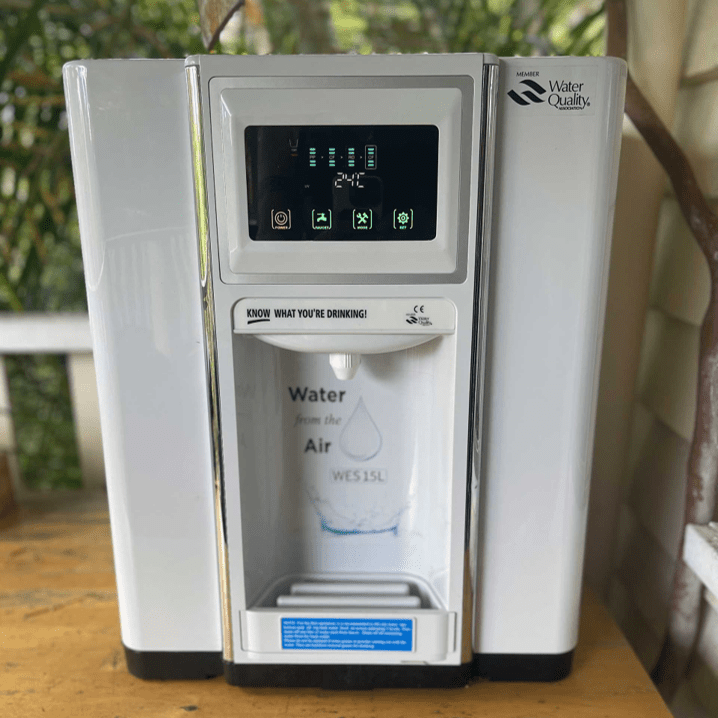
Atmospheric Water Generation
*providing sustainable water security
Coupled to ‘common’ wealth renewable energy generation infrastructure, Atmospheric Water Generators (AWGs) offer an innovative and sustainable solution for mobile communitarians transitioning to Living Simply and established communal union accommodation villages to access pure living water by harvesting water directly from the air.
These devices harness ambient humidity, providing a reliable source of water that is independent of chemical ladened mains water supplies, or natural water bodies. AWGs are especially beneficial in arid or drought-prone regions where access to safe drinking water is limited or non-existent. These machines eliminate reliance on bottled water, minimizing plastic waste and carbon emissions associated with transport and production.
Health Benefits: Consuming Pure Living Water
For those adhering to the principles of an evolved diet and lifestyle, water quality is a cornerstone of health and longevity, AWGs produce water by extracting moisture from the air, bypassing the contaminants often found in groundwater and municipal systems, such as chlorine, heavy metals, and microplastics. This process yields water that is free from harmful substances, and also vibrantly “living”, and therefore perfectly suited to nourishing our bodies.
When paired with remineralization strategies, AWGs can produce water that complements our dietary needs, offering essential trace minerals often missing in other water sources. For mobile accommodation villages, this means consistent access to high-quality hydration, regardless of location, supporting the vitality and unity of all associates.
Atmospheric Water Generation Versus Metal Tank Water Storage
Water from an Atmospheric Water Generator (AWG) is generally healthier and often more cost-effective in certain scenarios compared to rainwater harvested from roofs of Tiny Houses and other communal facilities and stored in galvanized water tanks. AWGs produce water by condensing moisture from the air, which typically undergoes filtration and purification processes, including UV treatment and carbon filtering, to ensure high-quality, contaminant-free drinking water. This process bypasses the risks associated with water stored in galvanized tanks, which can leach zinc or other metals over time, potentially compromising water safety if the tank is not properly maintained, or if the water is not routinely tested.
In terms of cost-effectiveness, AWGs can be advantageous in regions where water delivery or well-digging costs are high, or where consistent water quality requires ongoing treatment. While the initial investment in an AWG may be higher, the long-term operational costs, primarily electricity, can be offset by coupling the units to ‘common’ wealth collaborative provisioning renewable energy generation systems and minimizing health-related expenses from consuming contaminated water.
However, local climate, energy costs, and daily water needs can influence whether AWGs provide a more cost-efficient solution overall. In areas with abundant natural water sources and proper tank maintenance, a galvanized water tank will remain a viable option.
Cost Efficiency and Solar Integration
While the initial investment in AWGs might appear substantial, the long-term savings are significant, especially when considering the elimination of bottled water expenses and reduced reliance on external water supplies. Modern AWGs come in various sizes and capacities, with units designed for personal and larger collaborative living use. These units range from $1,500 to $10,000 depending on output and features.
The integration of solar energy further enhances cost efficiency. Solar panels can power AWGs, creating a fully self-sustained system that minimizes operational costs and environmental impact. Many manufacturers now offer solar-compatible models, and DIY enthusiasts can find numerous resources for building solar-powered AWGs.
By sharing the initial procurement costs and on-going maintenance expenses of AWG’s through ‘common purse’ collaborative provisioning, the best quality durable systems are able to be installed to equip mobile communal union accommodation facilities with clean, safe drinking water.
Environmental Advantages
By producing water directly from the air, AWGs eliminate the need for single-use plastic bottles, significantly reducing plastic waste. Moreover, these systems lessen dependency on traditional water infrastructure, which often involves energy-intensive transportation and treatment processes. For mobile communitarian villages, this means a reduced ecological footprint, allowing us contribute to conservation of finite land and sea resources.
AWGs also contribute to water conservation. Unlike traditional groundwater extraction, AWGs draw from the atmosphere, a virtually limitless resource when sustainably managed. This feature is especially valuable in areas where water scarcity challenges traditional supply methods.
Mobility & Flexibility
The portable nature of many AWG systems makes them ideal for mobile communitarian villages. Compact designs and energy-efficient operation ensure that these units can be transported and deployed with ease, even in remote locations. Whether stationed in arid deserts or humid forests, AWGs provide a reliable water source, fostering resilience and adaptability for the global network of communitarian unions dedicated to creating sustainable living human habitat to contribute to practical Love-in-action.
For larger-scale operations, communal AWGs can serve as centralized water stations, ensuring equitable access to water for all associates. When paired with solar energy systems, these units become even more versatile, capable of supporting the full array of needs for water for ‘common’ wealth, common purse mobile villages.
AWG Systems
Harvesting water from the atmosphere, commonly known as atmospheric water generation (AWG), involves extracting moisture from the air to produce clean water. There are a few different methods to achieve this end, each with its own technology and applications.
1. Condensation-Based Systems
1.1. Atmospheric Water Generators (AWGs)
Technology: These devices work by cooling air to below its dew point, causing moisture to condense into water. The process is similar to how water droplets form on a cold glass.
Components:
– Cooling Coils: Air is drawn over cooled coils where condensation occurs.
– Collection Tray: Condensed water collects in a tray.
– Filtration: Water is often filtered and treated to ensure it is clean and safe to drink.
– Types: There are several types of AWGs, including compressor-based (using refrigeration cycles) and desiccant-based (using materials that absorb moisture).
1.2. Dehumidifiers
Technology: Similar to AWGs, dehumidifiers extract moisture from the air but are primarily used for reducing humidity in buildings. They can also be used to collect water by directing the condensed water into a storage container.
Components:
– Cooling Coils: Air is cooled to condense moisture
– Water Collection Tank: Collects the water that drips off the coils
– Filters: Often have filters to remove particulates from the air and water
2. Solar Water Harvesting
2.1. Solar Still
Technology: A solar still uses solar energy to evaporate water from a saline or contaminated source, which then condenses on a cooler surface and is collected.
Components:
– Evaporation Basin: A shallow container that holds the water
– Glass or Transparent Cover: Allows sunlight to heat the water while preventing evaporation from escaping
– Condensation Surface: A cooler surface where water vapor condenses
– Collection Channel: Channels the condensed water into a separate container
2.2. Solar-Powered Condenser
Technology: Combines solar power with condensation technology. Solar panels provide energy to cool the air and facilitate condensation.
Components:
– Solar Panels: Provide the energy needed to power the cooling system.
– Cooling Unit: Uses the energy from solar panels to cool the air and condense moisture.
– Water Collection System: Collects and stores the condensed water
3. Fog Nets & Meshes
Technology: These systems capture water from fog by using large mesh nets or screens that intercept water droplets from fog or dew.
Components:
– Mesh Net: A large mesh or net structure placed in areas where fog is prevalent
– Collection Trough: Channels water droplets from the mesh to a storage container
– Installation: Often used in regions with frequent fog, such as coastal or mountainous areas
4. Atmospheric Water Harvester (AWH) Systems
Technology: Advanced systems that integrate various technologies to optimize water extraction from the air.
Components:
– Air Filtration: Removes particulates and contaminants from the air
– Cooling & Condensation Units: Extract moisture from the air
– Storage and Treatment: Collects and treats the water to ensure it is safe for use
Maintenance and Considerations
– Regular Cleaning: Keep filters and collection surfaces clean to ensure efficient operation and water quality.
– Water Quality Testing: Regularly test the harvested water to ensure it is free from contaminants.
– Energy Consumption: Some systems, especially those that rely on cooling, can have high energy demands. Consider energy-efficient options or renewable energy sources.
By selecting the right method for your environment and needs, you can effectively harvest water from the atmosphere for various uses, from drinking to irrigation.
Building AWG Systems
For those with a DIY spirit, constructing an AWG is a rewarding endeavour that aligns with our values of resourcefulness and ingenuity. Basic AWG systems can be created using dehumidifiers, air filters, and water collection units. When combined with solar panels, these systems become fully autonomous and environmentally friendly.
For those interested in exploring DIY options, websites such as Instructables feature guides on assembling basic AWG systems. These resources demonstrate how to pair solar panels with AWGs, Making them an accessible project for communal unions committed to recycling, repairing and repurposing resourcefulness.
Detailed guides on building homemade AWGs can be found on platforms like Permaculture Forums and DIY Renewable Energy Blogs. These resources offer step-by-step instructions, material lists, and troubleshooting tips, empowering associates to create their own water solutions tailored to the needs of their communal unions.
Embracing a Future of Self-Sufficiency
Atmospheric water generators embody the principles of Rich By Association Shared Prosperity and Deep Union by bringing to fruition the practices of maximizing health and vitality, sustainable living, and responsible environmental stewardship. For mobile communitarian union accommodation villages, these systems offer a path to sustainable water independence while fostering a deeper connection to our collective mission. By integrating AWGs with solar energy and embracing the concept of consuming Pure Living Water, we take a significant step toward realizing our vision of thriving, resourceful, and harmonious collaborative living.










